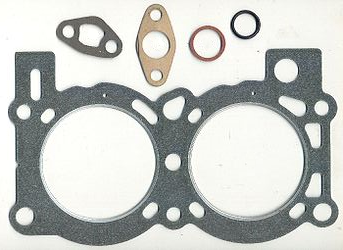A gasket is a
mechanical seal that fills the space between two
objects, generally to prevent leakage between the two
objects while under
compression. Gaskets save money by allowing
"less-than-perfect" mating surfaces on machine parts
which can use a gasket to fill irregularities. Gaskets
are commonly produced by cutting from sheet materials,
such as gasket
paper,
rubber,
silicone,
metal,
cork,
felt,
neoprene,
nitrile rubber,
fiberglass, or a
plastic
polymer (such as
polychlorotrifluoroethylene). Gaskets for specific
applications may contain
asbestos. It is usually desirable that the gasket be
made from a material that is to some degree yielding
such that it is able to deform and tightly fills the
space it is designed for, including any slight
irregularities. Many gaskets require an application of
sealant directly to the gasket surface to function
properly.

Gaskets come
in many different designs based on industrial usage,
budget, chemical contact and physical parameters:
Sheet gaskets
The premise
is simple in that a sheet of material (in older
situations the material would be compressed asbestos,
but now generally a fibrous material such as
graphite is used) has the gasket shape "punched
out" of it. This leads to a very crude, fast and
cheap gasket. These gaskets can fill many chemical
requirements based on the
inertness of the material used and fit many
budgetary restraints. Common practice prevents these
gaskets from being used in many industrial processes
based on temperature and pressure concerns.
Solid material
gaskets
The idea
behind solid material is to use metals which cannot be
punched out of sheets but are still cheap to produce.
These gaskets generally have a much higher level of
quality control than sheet gaskets and generally can
withstand much higher temperatures and pressures. The
key downside is that a solid metal must be greatly
compressed in order to become flush with the
flange head and prevent leakage. The material choice
is more difficult; because metals are primarily used,
process contamination and
oxidation are risks. An additional downside is that
the metal used must be softer than the flange — in order
to ensure that the flange does not warp and thereby
prevent sealing with future gaskets. Even so, these
gaskets have found a place in industry, although not a
large one.
Spiral-wound
gaskets
Spiral-wound
gasket utilizes a mix of metallic material and "filler
material" generally the gasket has a chosen metal,
normally a carbon rich or
stainless steel, wound (hence the name) outwards in
a circle (although other shapes are possible this is the
primary) with the filler material, generally a flexible
graphite, starting at the opposite side of the circle
and winding in the same direction. This leads to a
growing circle of alternating layers of filler and
metal. These gaskets have proven to be reliable in most
applications and although more expensive than solid
material they do not require as high of bolt forces to
be effective. This is possible mainly because the
graphite makes the primary seal with the flange and the
metal only acts to keep the gasket structurally sound.
Double-jacketed
gaskets
Double-jacketed (hence forth called DJ) gaskets are
another combination of filler material and metallic
materials. In this application, a tube with ends that
resemble a "C" is made of the metal with an additional
piece made to fit inside of the "C" making the tube
thickest at the meeting points. The filler is pumped
between the shell and piece. When in use the compressed
gasket has a larger amount of metal at the two tips
where contact is made (due to the shell/piece
interaction) and these two places bear the burden of
sealing the process. Since all that is needed is a shell
and piece, these gaskets can be made from almost any
material that can be made into a sheet and a filler can
than be inserted. This is an effective option for most
applications.
Kammprofile
gaskets
Kammprofile
gaskets are used in many older seals since they have
both a flexible nature and are great sealers.
Kammprofiles work by having a solid corrugated (many
equally spaced bumps) core with a flexible covering
layer. This arrangement allows for very high compression
and an extremely tight seal along the ridges of the
gasket. Since generally the graphite will fail instead
of the metal core, Kammprofile can be repaired when the
seal is not needed such as during a
shutdown of some kind. Kammprofile has a high
initial cost for most applications but this can be
justified both by long term savings and increased
reliability.








